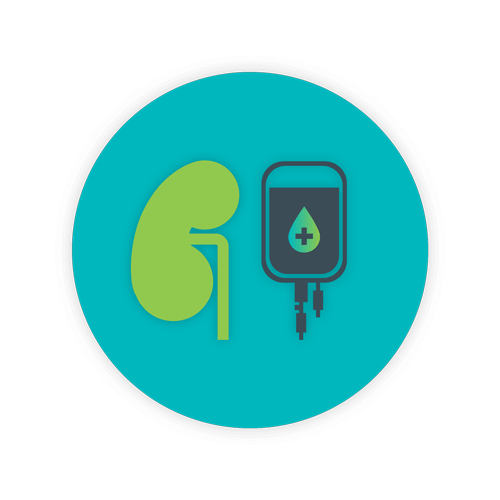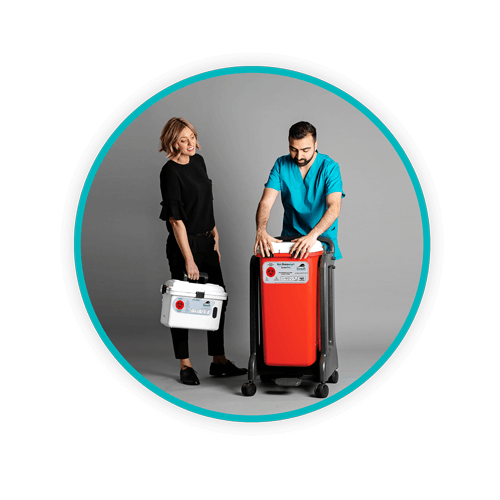How do Hospitals Dispose of Liquid Waste?

“Hey, just pour it down the drain.”
Have you ever heard that in your healthcare facility? Chances are that, at some point in your career, the thought has crossed your mind when it comes to disposal of liquid waste at your hospital facility. There is no doubt that the management of liquid waste in any medical facility – primarily hospitals – poses challenges. The challenges are not only relegated to actual disposal, but how to contain it based on type.
It’s not just about getting rid of the liquid medical waste – it’s about staff safety and of course, your bottom line! The fines and penalties associated with non-compliance are massive, not to mention the damage to your reputation! Save yourself the headache by practicing compliant segregation and disposal of medical waste.
TOPICS WE WILL COVER:
01 / What types of fluid compose hospital liquid waste?
02 / What type of fluid waste is regulated medical waste?
03 / What to do with liquid medical waste
04 / Understanding CDC Requirements
05 / How Daniels can support you
What types of fluid compose hospital liquid waste?
Hospitals have to deal with numerous types of liquid waste disposal. Each of those types of fluids have requirements in regard to healthcare waste management, segregation, as well as liquid disposal procedures. Just a few types of liquid wastes hospital employees come across include:
- Dialysis waste
- Lab cultures and specimens
- Chemotherapy drugs and other liquid medications
- Spinal fluids
- Blood and blood byproducts
- Amniotic fluids
- A number of bodily secretions and fluids
How do you get rid of it all? What about collection processes? What about safety?
Fluid medical waste can and does spill. It may also be infectious. Certain protocols and personal protective equipment (PPE) may be required to clean up a medical spill. Fluid medical wastes may be biohazardous or infectious. Such wastes can be contaminated by a number of pathogens including HIV, hepatitis B, or viruses.
Some fluids, including chemotherapy drugs and medications, may be classified as biohazard waste by Resource Conservation and Recovery Act (RCRA) legislation, and each type may require specific methods and regulations in regard to containment, storage, labeling, and disposal. Biomedical waste management is a must!
What type of fluid waste is regulated medical waste?
Better to be safe than sorry. In fact, the majority of liquid medical waste gathered in a hospital environment may very well be classified as regulated medical waste.
What about that liquid medical waste that gets sucked into a suction canister at the point of origin in the ER, a patient’s room, or a surgical suite? What about fluid saturated materials that were used to clean up a spill (of literally any kind)? What about blood-saturated gauze or soiled personal protective equipment (PPE)? You may not typically consider that liquid medical waste, but at a certain level of saturation, special regulations apply.
In a compliant hospital environment, and other medical facilities, liquid medical wastes are typically segregated and placed in a specifically designed and labeled container that is designed to contain liquid and is puncture proof, leak-proof, and spill-proof. Before such liquid wastes even leave the medical facility for disposal, liquid wastes must be properly packaged and labeled under regulated medical waste requirements. In fact, potentially infectious liquid medical waste must be packaged differently than ‘regular’ and non-infectious liquid waste.
What to do with liquid medical waste

It can be time-consuming, often frustrating, and expensive to deal with liquid waste from a hospital. However, there are certain things that hospital employees should never, ever do with liquid waste because it can be dangerous, such as “pouring it down the drain”.
The handling, packaging, containment, and disposal of liquid medical waste in a hospital environment ranges from operating suites to patient rooms. For example, disposal of fluid medical waste from an operating suite must not only be efficient and compliant, but hopefully, cost-effective while at the same time protecting all members of the medical care team from exposure to dangerous viruses or bacteria and blood-borne pathogens.
Storage and management of liquid medical waste is mainly regulated by the Occupational Safety and Health Administration (OSHA), and then from the federal level to state levels. OSHA has a very specific definition of regulated medical waste as:
- “Liquid or semiliquid blood or other potentially infectious materials;
- Contaminated items that would release blood or other potentially infectious materials in a liquid or semi liquid state if compressed;
- Items caked with dried blood or other potentially infectious materials that are also capable of releasing such materials during handling;
- Contaminated sharps;
- Pathological and microbiological waste containing blood or other potentially infectious materials.”
Understanding CDC Requirements
According to the CDC, the discharge of blood or fluids to sanitary sewers or septic tanks requires special handling. State regulations are responsible for dictating maximum volume of bodily fluid wastes including blood. Always refer to state regulations when it comes to even small amounts of body fluids.
For example, California statutes require that specimens of blood or OPIM (Other Potentially Infectious Materials) be placed in containers that prevent any kind of leakage during collection, handling, processing, storage, transport, or shipping. Containers must be labeled or color-coded based on state regulations.
In the state of Arizona, human blood and blood products, human pathologic wastes, and research animal wastes, including medical sharps, cultures, and stocks are listed under Arizona’s Biohazardous Medical Waste Rules as mandated by the Arizona Department of Environmental Quality. Packaging requirements stipulate that any biohazard waste, including liquids, be placed in containers that are impervious to moisture, are leak-resistant, and of sufficient strength to prevent bursting or tearing under “normal conditions of use and handling”. They must be sealed to prevent leakage during transport, among other regulations.
Even though many hospital systems today utilize closed or sealed systems for dealing with liquid medical waste, healthcare employees should always utilize appropriate methods and procedures, including the use of personal protective equipment and care when handling and disposing of canisters containing liquid fluids in order to prevent unintentional exposure.
Daniels Health ensures compliance
Daniels Health provides numerous resources solutions, and products for healthcare waste management and segregation, including that of liquid wastes and disposal. Stay compliant, protect your employees, and void fines and penalties for non-compliance. Hospitals can be charged tens of thousands of dollars per day per incident for non-compliant handling of all types of medical waste. To find out how we can help you with your hospitals disposal of liquid waste, contact us today. Alternative, explore our hospital waste management solutions below:
Let's Talk!
Your time is valuable, and we don’t want to play hard to get. You can either phone us directly on the details listed on our contact page, or feel free to fill out this short form and one of our team members will get back to you as quickly as possible.

